|
Energy efficiency in transport
The energy efficiency in transport is the useful travelled distance, of passengers, goods or any type of load; divided by the total energy put into the transport propulsion means. The energy input might be rendered in several different types depending on the type of propulsion, and normally such energy is presented in liquid fuels, electrical energy or food energy.[1][2] The energy efficiency is also occasionally known as energy intensity.[3] The inverse of the energy efficiency in transport is the energy consumption in transport. Energy efficiency in transport is often described in terms of fuel consumption, fuel consumption being the reciprocal of fuel economy.[2] Nonetheless, fuel consumption is linked with a means of propulsion which uses liquid fuels, whilst energy efficiency is applicable to any sort of propulsion. To avoid said confusion, and to be able to compare the energy efficiency in any type of vehicle, experts tend to measure the energy in the International System of Units, i.e., joules. Therefore, in the International System of Units, the energy efficiency in transport is measured in terms of metre per joule, or m/J, while the energy consumption in transport is measured in terms of joules per metre, or J/m. The more efficient the vehicle, the more metres it covers with one joule (more efficiency), or the fewer joules it uses to travel over one metre (less consumption). The energy efficiency in transport largely varies by means of transport. Different types of transport range from some hundred kilojoules per kilometre (kJ/km) for a bicycle to tens of megajoules per kilometre (MJ/km) for a helicopter. Via type of fuel used and rate of fuel consumption, energy efficiency is also often related to operating cost ($/km) and environmental emissions (e.g. CO2/km). Units of measurementIn the International System of Units, the energy efficiency in transport is measured in terms of metre per joule, or m/J. Nonetheless, several conversions are applicable, depending on the unit of distance and on the unit of energy. For liquid fuels, normally the quantity of energy input is measured in terms of the liquid's volume, such as litres or gallons. For propulsion which runs on electricity, normally kWh is used, while for any type of human-propelled vehicle, the energy input is measured in terms of Calories. It is typical to convert between different types of energy and units. For passenger transport, the energy efficiency is normally measured in terms of passengers times distance per unit of energy, in the SI, passengers metres per joule (pax.m/J); while for cargo transport the energy efficiency is normally measured in terms of the mass of transported cargo times distance per unit of energy, in the SI, kilograms metres per joule (kg.m/J). Volumetric efficiency with respect to vehicle capacity may also be reported, such as passenger-mile per gallon (PMPG),[4] obtained by multiplying the miles per gallon of fuel by either the passenger capacity or the average occupancy.[5] The occupancy of personal vehicles is typically lower than capacity by a considerable degree[6][7] and thus the values computed based on capacity and on occupancy will often be quite different. Typical conversions into SI unit
Liquid fuelsEnergy efficiency is expressed in terms of fuel economy:[2]
Energy consumption (reciprocal efficiency)[3] is expressed terms of fuel consumption:[2]
ElectricityElectricity consumption:
Producing electricity from fuel requires much more primary energy than the amount of electricity produced. Food energyEnergy consumption:
Land Passenger TransportTable OverviewIn the following table the energy efficiency and energy consumption for different types of passenger land vehicles and modes of transport, as well as standard occupancy rates, are presented. The sources for these figures are in the correspondent section for each vehicle, in the following article. The conversions amongst different types of units, are well known in the art. For the conversion amongst units of energy in the following table, 1 litre of petrol amounts to 34.2 MJ, 1 kWh amounts to 3.6 MJ and 1 kilocalorie amounts to 4184 J. For the car occupation ratio, the value of 1.2 passengers per automobile[13] was considered. Nonetheless, in Europe this value slightly increases to 1.4.[14] The sources for conversions amongst units of measurements appear only of the first row.
Land transport meansWalking A 68 kg (150 lb) person walking at 4 km/h (2.5 mph) requires approximately 210 kilocalories (880 kJ) of food energy per hour, which is equivalent to 4.55 km/MJ.[15] 1 US gal (3.8 L) of petrol contains about 114,000 British thermal units (120 MJ)[52] of energy, so this is approximately equivalent to 360 miles per US gallon (0.65 L/100 km). VelomobileVelomobiles (enclosed recumbent bicycles) have the highest energy efficiency of any known mode of personal transport because of their small frontal area and aerodynamic shape. At a speed of 50 km/h (31 mph), the velomobile manufacturer WAW claims that only 0.5 kWh (1.8 MJ) of energy per 100 km is needed to transport the passenger (= 18 J/m). This is around 1⁄5 (20%) of what is needed to power a standard upright bicycle without aerodynamic cladding at same speed, and 1⁄50 (2%) of that which is consumed by an average fossil fuel or electric car (the velomobile efficiency corresponds to 4700 miles per US gallon, 2000 km/L, or 0.05 L/100 km).[22] Real energy from food used by human is 4–5 times more.[20] Unfortunately their energy efficiency advantage over bicycles becomes smaller with decreasing speed and disappears at around 10 km/h where power needed for velomobiles and triathlon bikes are almost the same.[53] Bicycle A standard lightweight, moderate-speed bicycle is one of the most energy-efficient forms of transport. Compared with walking, a 64 kg (140 lb) cyclist riding at 16 km/h (10 mph) requires about half the food energy per unit distance: 27 kcal/km, 3.1 kWh (11 MJ) per 100 km, or 43 kcal/mi.[15] This converts to about 732 mpg‑US (0.321 L/100 km; 879 mpg‑imp).[54] This means that a bicycle will use between 10 and 25 times less energy per distance travelled than a personal car, depending on fuel source and size of the car. This figure does depend on the speed and mass of the rider: greater speeds give higher air drag and heavier riders consume more energy per unit distance. In addition, because bicycles are very lightweight (usually between 7–15 kg) this means they consume very low amounts of materials and energy to manufacture. In comparison to an automobile weighing 1500 kg or more, a bicycle typically requires 100–200 times less energy to produce than an automobile. In addition, bicycles require less space both to park and to operate and they damage road surfaces less, adding an infrastructural factor of efficiency. Motorised bicycleA motorised bicycle allows human power and the assistance of a 49 cm3 (3.0 cu in) engine, giving a range of 160 to 200 mpg‑US (1.5–1.2 L/100 km; 190–240 mpg‑imp).[citation needed] Electric pedal-assisted bikes run on as little as 1.0 kWh (3.6 MJ) per 100 km,[55] while maintaining speeds in excess of 30 km/h (19 mph).[citation needed] These best-case figures rely on a human doing 70% of the work, with around 3.6 MJ (1.0 kWh) per 100 km coming from the motor. This makes an electric bicycle one of the most efficient possible motorised vehicles, behind only a motorised velomobile and an electric unicycle (EUC). Electric kick scooter Electric kick scooters, such as those used by scooter-sharing systems like Bird or Lime, typically have a maximum range of under 30 km (19 mi) and are commonly limited to a maximum speed of 25 km/h (15.5 mph).[26] Intended to fit into a last mile niche and be ridden in bike lanes, they require little skill from the rider. Because of their light weight and small motors, they are extremely energy-efficient with a typical energy efficiency of 1.1 kWh (4.0 MJ) per 100 km[56] (1904 MPGe 810 km/L 0.124 L/100 km), even more efficient than bicycles and walking. However, as they must be recharged frequently, they are often collected overnight with motor vehicles, somewhat negating this efficiency. The lifecycle of electric scooters is also notably shorter than that of bicycles, often reaching only a single digit number of years. Electric UnicycleAn electric unicycle (EUC) cross electric skateboard variant called the Onewheel Pint can carry a 50 kg person 21.5 km at an average speed of 20 km/h. The battery holds 148Wh. Without taking energy lost to heat in the charging stage into account, this equates to an efficiency of 6.88Wh/km or 0.688kWh/100 km.[citation needed] Additionally, with regenerative braking as a standard design feature, hilly terrain would have less impact on an EUC compared to a vehicle with friction brakes such as a push bike. This combined with the single wheel ground interaction may make the EUC the most efficient known vehicle at low speeds (below 25 km/h), with the velomobile overtaking the position as most efficient at higher speeds due to superior aerodynamics. Automobiles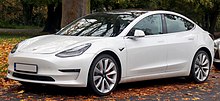 Automobiles are generally inefficient when compared to other modes of transport, due to the relatively high weight of the vehicle compared to its occupants. On a percentage basis, if there is one occupant in an automobile, only about 0.5% of the total energy used is used to move the person in the car, while the remaining 99.5% (about 200 times more) is used to move the car itself. An important driver of energy consumption of cars per passenger is the occupancy rate of the vehicle. Although the consumption per unit distance per vehicle increases with increasing number of passengers, this increase is slight compared to the reduction in consumption per unit distance per passenger. This means that higher occupancy yields higher energy efficiency per passenger. Automobile occupancy varies across regions. For example, the estimated average occupancy rate is about 1.3 passengers per car in the San Francisco Bay Area,[58] while the 2006 UK estimated average is 1.58.[59] Due to the efficiency of electric motors, electric cars are much more efficient than their internal combustion engine counterparts, consuming on the order of 38 megajoules (38 000 kJ) per 100 km in comparison to 142 megajoules per 100 km for combustion powered cars.[60] However, depending on the way the electricity is generated, the actual primary energy use may be higher. Driving practices and vehicles can be modified to improve their energy efficiency by about 15%.[61][62] Common efficiency measuresAutomobile fuel efficiency is most commonly expressed in terms of the volume of fuel consumed per one hundred kilometres (l/100 km), but in some countries (including the United States, the United Kingdom and India) it is more commonly expressed in terms of the distance per volume fuel consumed (km/L or miles per gallon). This is complicated by the different energy content of fuels such as petrol and diesel. The Oak Ridge National Laboratory (ORNL) states that the energy content of unleaded petrol is 115,000 British thermal unit (BTU) per US gallon (32 MJ/L) compared to 130,500 BTU per US gallon (36.4 MJ/L) for diesel.[63] Life-cycle energy use Automobiles have significant energy use in their life cycle, not directly attributable to the running of the vehicle. An important consideration is the energy costs of producing the energy form used by the automobile. Bio-fuels, electricity and hydrogen, for instance, have significant energy inputs in their production. Hydrogen production efficiency are 50–70% when produced from natural gas, and 10–15% from electricity.[citation needed] The efficiency of hydrogen production, as well as the energy required to store and transport hydrogen, must to be combined with the vehicle efficiency to yield net efficiency.[64] Because of this, hydrogen automobiles are one of the least efficient means of passenger transport, generally around 50 times as much energy must be put into the production of hydrogen compared to how much is used to move the car.[citation needed] Another important factor is the energy needed to build and maintain roads is an important consideration, as is the energy returned on energy invested (EROEI). Between these two factors, roughly 20% must be added to the energy of the fuel consumed, to accurately account for the total energy used.[citation needed] Finally, vehicle energy efficiency calculations would be misleading without factoring the energy cost of producing the vehicle itself. This initial energy cost can of course be depreciated over the life of the vehicle to calculate an average energy efficiency over its effective life span. In other words, vehicles that take a lot of energy to produce and are used for relatively short periods will require a great deal more energy over their effective lifespan than those that do not, and are therefore much less energy efficient than they may otherwise seem. Hybrid and electric cars use less energy in their operation than comparable petroleum-fuelled cars but more energy is used to manufacture them, so the overall difference would be less than immediately apparent. Compare, for example, walking, which requires no special equipment at all, and an automobile, produced in and shipped from another country, and made from parts manufactured around the world from raw materials and minerals mined and processed elsewhere again, and used for a limited number of years. According to the French energy and environment agency ADEME,[65] an average motor car has an embodied energy content of 20,800 kWh and an average electric vehicle amounts to 34,700 kWh. The electric car requires nearly twice as much energy to produce, primarily due to the large amount of mining and purification necessary for the rare earth metals and other materials used in lithium-ion batteries and in the electric drive motors. This represents a significant portion of the energy used over the life of the car (in some cases nearly as much as energy that is used through the fuel that is consumed, effectively doubling the car's per-distance energy consumption), and cannot be ignored when comparing automobiles to other transport modes. As these are average numbers for French automobiles and they are likely to be significantly larger in more auto-centric countries like the United States and Canada, where much larger and heavier cars are more common. The usage of private vehicles can be significantly decreased and can help to promote sustainable urban growth if more appealing non-motorized transportation options are developed, as well as more comfortable public transportation environments.[66] Example consumption figures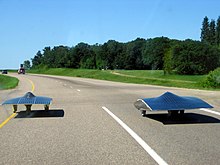
Trains Trains are in general one of the most efficient means of transport for freight and passengers. Advantages of trains include low friction of steel wheels on steel rails, as well as an intrinsic high occupancy rate. Train lines are typically used to serve urban or inter-urban transit applications where their capacity utilization is maximized. Efficiency varies significantly with passenger loads, and losses incurred in electricity generation and supply (for electrified systems),[75][76] and, importantly, end-to-end delivery, where stations are not the originating final destinations of a journey. While electric motors used in most passenger trains are more efficient than internal combustion engines,[77] power generation in thermal power plants is limited to (at best) Carnot efficiency[78] and there are transmission losses on the way from the power plant to the train.[79] Switzerland, which has electrified virtually its entire railway network (heritage railways like the Dampfbahn Furka-Bergstrecke being notable exceptions), derives much of the electricity used by trains from hydropower, including pumped hydro storage.[80] While the mechanical efficiency of the turbines involved is comparatively high, pumped hydro involves energy losses and is only cost effective as it can consume energy during times of excess production (leading to low or even negative spot prices) and release the energy again during high-demand times.[81][82][83][84] with some sources claiming up to 87%.[85] Actual consumption depends on gradients, maximum speeds, and loading and stopping patterns. Data produced for the European MEET project (Methodologies for Estimating Air Pollutant Emissions) illustrate the different consumption patterns over several track sections. The results show the consumption for a German ICE high-speed train varied from around 19 to 33 kW⋅h/km (68–119 MJ/km; 31–53 kW⋅h/mi). The Siemens Velaro D type ICE trains seat 460 (16 of which in the restaurant car) in their 200-meter length edition of which two can be coupled together.[86] Per Deutsche Bahn calculations, the energy used per 100 seat-km is the equivalent of 0.33 litres (12 imp fl oz) of gasoline (0.33 litres per 100 kilometres (860 mpg‑imp; 710 mpg‑US)).[87][88] The data also reflects the weight of the train per passenger. For example, TGV double-deck Duplex trains use lightweight materials, which keep axle loads down and reduce damage to track and also save energy.[89] The TGV mostly runs on French nuclear fission power plants which are again limited – as all thermal power plants – to Carnot efficiency. Due to nuclear reprocessing being standard operating procedure, a higher share of the energy contained in the original Uranium is used in France than in e.g. the United States with its once thru fuel cycle.[90] The specific energy consumption of the trains worldwide amounts to about 150 kJ/pkm (kilojoule per passenger kilometre) and 150 kJ/tkm (kilojoule per tonne kilometre) (ca. 4.2 kWh/100 pkm and 4.2 kWh/100 tkm) in terms of final energy. Passenger transportation by rail systems requires less energy than by car or plane (one seventh of the energy needed to move a person by car in an urban context,[45]). This is the reason why, although accounting for 9% of world passenger transportation activity (expressed in pkm) in 2015, rail passenger services represented only 1% of final energy demand in passenger transportation.[91][92] FreightEnergy consumption estimates for rail freight vary widely, and many are provided by interested parties. Some are tabulated below.
Passenger
Braking losses Having to accelerate and decelerate a heavy train load of people at every stop is inefficient. Modern electric trains therefore use regenerative braking to return current into the catenary while they brake. The International Union of Railways has stated[107] that full stop service commuter trains reduce emissions by 8-14% by employing regenerative braking, and very dense suburban network trains by ~30%. High-speed electric trains like the N700 Series Shinkansen (the Bullet Train) employ regenerative braking, but due to the high speed, UIC estimates regenerative braking to only reduce emissions by 4.5%. Buses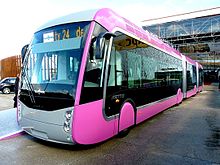
Other
Air transport meansAircraft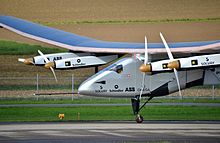 A principal determinant of energy consumption in aircraft is drag, which must be in the opposite direction of motion to the craft.
Passenger airplanes averaged 4.8 L/100 km per passenger (1.4 MJ/passenger-km) (49 passenger-miles per gallon) in 1998.[citation needed] On average 20% of seats are left unoccupied. Jet aircraft efficiencies are improving: Between 1960 and 2000 there was a 55% overall fuel efficiency gain (if one were to exclude the inefficient and limited fleet of the DH Comet 4 and to consider the Boeing 707 as the base case).[114] Most of the improvements in efficiency were gained in the first decade when jet craft first came into widespread commercial use. Compared to advanced piston engine airliners of the 1950s, current jet airliners are only marginally more efficient per passenger-mile.[115] Between 1971 and 1998 the fleet-average annual improvement per available seat-kilometre was estimated at 2.4%. Concorde the supersonic transport managed about 17 passenger-miles to the Imperial gallon; similar to a business jet, but much worse than a subsonic turbofan aircraft. Airbus puts the fuel rate consumption of their A380 at less than 3 L/100 km per passenger (78 passenger-miles per US gallon).[116]  The mass of an aircraft can be reduced by using light-weight materials such as titanium, carbon fibre and other composite plastics. Expensive materials may be used, if the reduction of mass justifies the price of materials through improved fuel efficiency. The improvements achieved in fuel efficiency by mass reduction, reduces the amount of fuel that needs to be carried. This further reduces the mass of the aircraft and therefore enables further gains in fuel efficiency. For example, the Airbus A380 design includes multiple light-weight materials. Airbus has showcased wingtip devices (sharklets or winglets) that can achieve 3.5 percent reduction in fuel consumption.[117][118] There are wingtip devices on the Airbus A380. Further developed Minix winglets have been said to offer 6 percent reduction in fuel consumption.[119] Winglets at the tip of an aircraft wing smooth out the wing-tip vortex (reducing the aircraft's wing drag) and can be retrofitted to any airplane.[119] NASA and Boeing are conducting tests on a 500 lb (230 kg) "blended wing" aircraft. This design allows for greater fuel efficiency since the whole craft produces lift, not just the wings.[120] The blended wing body (BWB) concept offers advantages in structural, aerodynamic and operating efficiencies over today's more conventional fuselage-and-wing designs. These features translate into greater range, fuel economy, reliability and life cycle savings, as well as lower manufacturing costs.[121][122] NASA has created a cruise efficient STOL (CESTOL) concept. Fraunhofer Institute for Manufacturing Engineering and Applied Materials Research (IFAM) have researched a shark skin imitating paint that would reduce drag through a riblet effect.[123] Aircraft are a major potential application for new technologies such as aluminium metal foam and nanotechnology such as the shark skin imitating paint. Propeller systems, such as turboprops and propfans are a more fuel efficient technology than jets. But turboprops have an optimum speed below about 450 mph (700 km/h).[124] This speed is less than used with jets by major airlines today. With the current [needs update] high price for jet fuel and the emphasis on engine/airframe efficiency to reduce emissions, there is renewed interest in the propfan concept for jetliners that might come into service beyond the Boeing 787 and Airbus A350XWB. For instance, Airbus has patented aircraft designs with twin rear-mounted counter-rotating propfans.[125] NASA has conducted an Advanced Turboprop Project (ATP), where they researched a variable pitch propfan that produced less noise and achieved high speeds. Related to fuel efficiency is the impact of aviation emissions on climate. Small aircraft
Water transport meansShipsQueen Elizabeth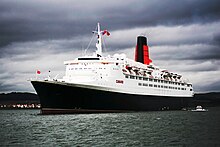 Cunard stated that Queen Elizabeth 2 travelled 49.5 feet per imperial gallon of diesel oil (3.32 m/L or 41.2 ft/US gal), and that it had a passenger capacity of 1777.[129] Thus carrying 1777 passengers we can calculate an efficiency of 16.7 passenger miles per imperial gallon (16.9 L/100 p·km or 13.9 p·mpg–US). Cruise shipsMS Oasis of the Seas has a capacity of 6,296 passengers and a fuel efficiency of 14.4 passenger miles per US gallon. Voyager-class cruise ships have a capacity of 3,114 passengers and a fuel efficiency of 12.8 passenger miles per US gallon.[130] Emma MaerskEmma Maersk uses a Wärtsilä-Sulzer RTA96-C, which consumes 163 g/kWh and 13,000 kg/h. If it carries 13,000 containers then 1 kg fuel transports one container for one hour over a distance of 45 km. The ship takes 18 days from Tanjung (Singapore) to Rotterdam (Netherlands), 11 from Tanjung to Suez, and 7 from Suez to Rotterdam,[131] which is roughly 430 hours, and has 80 MW, +30 MW. 18 days at a mean speed of 25 knots (46 km/h) gives a total distance of 10,800 nautical miles (20,000 km). Assuming the Emma Maersk consumes diesel (as opposed to fuel oil which would be the more precise fuel) then 1 kg diesel = 1.202 litres = 0.317 US gallons. This corresponds to 46,525 kJ. Assuming a standard 14 tonnes per container (per teu) this yields 74 kJ per tonne-km at a speed of 45 km/h (24 knots). BoatsA sailboat, much like a solar car, can locomote without consuming any fuel. A sail boat such as a dinghy using just wind power requires no input energy in terms of fuel. However some manual energy is required by the crew to steer the boat and adjust the sails using lines. In addition energy will be needed for demands other than propulsion, such as cooking, heating or lighting. The fuel efficiency of a single-occupancy boat is highly dependent on the size of its engine, the speed at which it travels, and its displacement. With a single passenger, the equivalent energy efficiency will be lower than in a car, train, or plane.[citation needed] International transport comparisons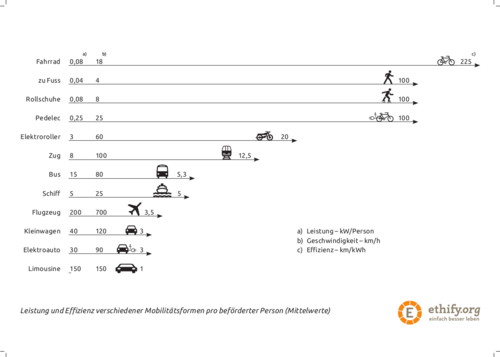 European Public transportRail and bus are generally required to serve 'off peak' and rural services, which by their nature have lower loads than city bus routes and inter city train lines. Moreover, due to their 'walk on' ticketing it is much harder to match daily demand and passenger numbers. As a consequence, the overall load factor on UK railways is 35% or 90 people per train:[132] Conversely, airline services generally work on point-to-point networks between large population centres and are 'pre-book' in nature. Using yield management, overall load factors can be raised to around 70–90%. Intercity train operators have begun to use similar techniques, with loads reaching typically 71% overall for TGV services in France and a similar figure for the UK's Virgin Rail Group services.[133] For emissions, the electricity generating source needs to be taken into account.[134][135] [136] US Passenger transportThe US Transport Energy Data Book states the following figures for passenger transport in 2018. These are based on actual consumption of energy, at whatever occupancy rates there were. For modes using electricity, losses during generation and distribution are included. Values are not directly comparable due to differences in types of services, routes, etc.[137]
US Freight transportThe US Transport Energy book states the following figures for freight transport in 2010:[105][138][139][140]
From 1960 to 2010 the efficiency of air freight has increased 75%, mostly due to more efficient jet engines.[141] 1 gal-US (3.785 L, 0.833 gal-imp) of fuel can move a ton of cargo 857 km or 462 nmi by barge, or 337 km (209 mi) by rail, or 98 km (61 mi) by lorry.[142] Compare:
Canadian transportNatural Resources Canada's Office of Energy Efficiency publishes annual statistics regarding the efficiency of the entire Canadian fleet. For researchers, these fuel consumption estimates are more realistic than the fuel consumption ratings of new vehicles, as they represent the real world driving conditions, including extreme weather and traffic. The annual report is called Energy Efficiency Trends Analysis. There are dozens of tables illustrating trends in energy consumption expressed in energy per passenger km (passengers) or energy per tonne km (freight).[143] French environmental calculatorThe environmental calculator of the French environment and energy agency (ADEME) published in 2007 using data from 2005[144] enables one to compare the different means of transport as regards the CO2 emissions (in terms of carbon dioxide equivalent) as well as the consumption of primary energy. In the case of an electric vehicle, the ADEME makes the assumption that 2.58 toe as primary energy are necessary for producing one toe of electricity as end energy in France (see Embodied energy: In the energy field). This computer tool devised by the ADEME shows the importance of public transport from an environmental point of view. It highlights the primary energy consumption as well as the CO2 emissions due to transport. Due to the relatively low environmental impact of radioactive waste, compared to that of fossil fuel combustion emissions, this is not a factor in the tool. Moreover, intermodal passenger transport is probably a key to sustainable transport, by allowing people to use less polluting means of transport. German environmental costsDeutsche Bahn calculates the energy consumption of their various means of transportation.[145]
Note - External costs not included aboveTo include all the energy used in transport, we would need to also include the external energy costs of producing, transporting and packaging of fuel (food or fossil fuel or electricity), the energy incurred in disposing of exhaust waste, and the energy costs of manufacturing the vehicle. For example, a human walking requires little or no special equipment while automobiles require a great deal of energy to produce and have relatively short product lifespans. However, these external costs are independent of the energy cost per distance travelled, and can vary greatly for a particular vehicle depending on its lifetime, how often it is used and how it is energized over its lifetime. Thus this article's numbers include none of these external factors. See also
Footnotes
External links |
|||||||||||||||||||||||||||||||||||||||||||||||||||||||||||||||||||||||||||||||||||||||||||||||||||||||||||||||||||||||||||||||||||||||||||||||||||||||||||||||||||||||||||||||||||||||||||||||||||||||||||||||||||||||||||||||||||||||||||||||||||||||||||||||||||||||||||||||||||||||||||||||||||||||||||||||||||||||||||||||||||||||||||||||||||||||||||||||||||||||||||||||||||||||||||||||||||||||||||||||||||||||||||||||||||||||||||||||||||||||||||||||||||||||||||||||||||||||||||||||||||||||||||||||||||||||||||||||||||||||||||||||||||||||||||||||||||||||||||||||||||||||||||||||||||||||||||||||||||||||||||||||||||||||||||||||||||||||||||||||||||||||||||||||||||||||||||